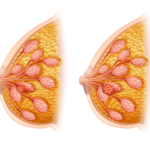The following treatments for breast cancer can cause nail changes:
CHEMOTHERAPY:
Adriamycin (chemical name: doxorubicin)
Daunorubicin (brand names: Cerubidine, DaunoXome)
Doxil (chemical name: doxorubicin)
Ixempra (chemical name: ixabepilone)
Mitoxantrone (brand name: Novantrone)
Taxotere (chemical name: docetaxel)
Tamoxifen
Nail Changes
The risk of developing these types of changes is high for some treatments. For others, the risk is much lower. Your healthcare provider will discuss your treatments and your risk of developing nail changes. You may have any of the following nail changes in some or all of your nails:
- Changes in the color of your nails (dark or light)
- Nails that break easily are more brittle or split
- Changes in nail shape or texture, such as grooves or ridges
- Nail separation from the skin below. This may or may not be painful
- Discharge or fluid from under the nail that may smell, be painful, or both. This may be an infection
- Swelling in the tips of your fingers or toes (with or without redness)
- Pain around the fingers or toenails
- Slowed nail growth
- Nails that grow into your skin
- Development on the side of your nails or opened skin around the nail
These nail changes can involve your nail plate, nail bed, the area around or under your nail, or all these areas
Figure 1. The parts of your nail

How to Care for Your Skin and Nails During Cancer Treatment
- Keep your nails short (and don’t bite them) as soon as you start chemo. Ensure the edges are straight and smooth, so not too short on the outside. This prevents ingrown nails or possible infections
- Your nails will benefit from additional moisturizing to avoid dryness during chemo. You can use a special nail oil or cream, but an excellent nourishing hand cream might be all you need
- Massage the cream into your cuticles, the skin around your nails, and the nails themselves. And don’t forget your toenails!
- Use soaps and moisturizers recommended by your doctor. Stick with gentle, fragrance-free soaps, and use creams or ointments to protect your skin from getting dry
- Use lukewarm or warm water to keep showers and baths short. Limit showers to once a day and baths to twice a week
- Avoid tanning beds, and wear sun hats, sunscreen, and long sleeves when in the sun
- Skip acrylics or nail wraps during your cancer treatment. Moisturizing is a better option than fake nails, which can trap bacteria
How long will it take before my nails look normal again after my cancer treatment?
Your nails will recover after the chemo. This takes a few months for some people and others, a year or longer. Talk to your doctor if you experience difficulties or pain during your recovery. They can refer you to specialists for treatments if necessary.
Can I have a professional manicure while undergoing chemotherapy?
Some people avoid professional manicures or pedicures, but the main reason is to prevent the risk of infection as the immune system is weakened during chemotherapy treatment, and nail salons can often harbor bacteria. If you want a professional manicure, ensure the nail technician’s hygiene standards are up to scratch, or take your sanitized instruments.
It is advisable to avoid using artificial nails. Artificial nail adhesives have chemicals that may cause an allergic reaction, such as swelling or inflammation. Fake nails can also trap bacteria that may cause infections.
Can I use nail polish while going through chemotherapy treatment?
There is a lot of conflicting advice about whether you can use nail varnish during chemotherapy treatment. Polish will dry nails, so using a moisturizer or a strengthener might be better if the nails are already very dry or falling off.
Discuss side effects with your doctor
Keep an eye on your nails during and after your chemotherapy treatment, and talk with your doctor or oncologist about side effects you may be experiencing. They can help you treat and prevent complications like nail loss and secondary infections.
Having an ongoing dialogue with your doctor or oncologist about what you’re experiencing is essential. Your doctor might have strategies and recommendations to remedy side effects and ease discomfort during and after chemotherapy.
REFERENCES
Breastcancer.org
CancerPal
City of Hope
Healthline
Memorial Sloan Kettering CancerCenter
UPMC









